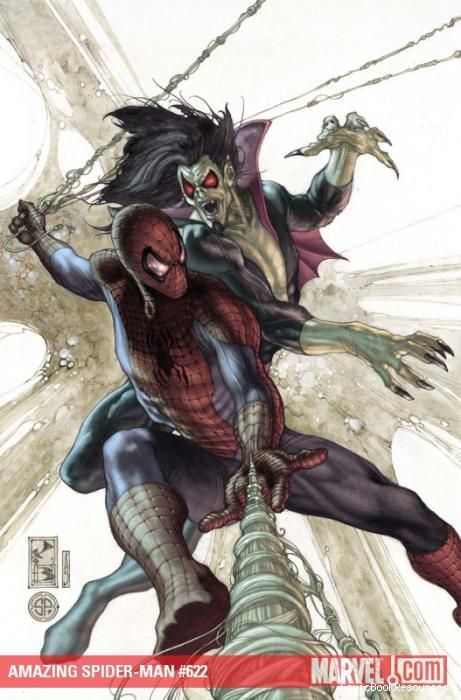This issue is a bit of a reprieve from "The Gauntlet" and almost seems like a fill-in. While this is undoubtedly a Spider-Man book, the focus isn't on the webhead, but rather on Morbius and Flash Thompson. It's the 1970s all over again.
Morbius has never held much appeal to me, but in the wake of the "Twilight" frenzy that's run over pop culture recently (with more waves to come, certainly), it seems everybody and their brother is trying to capitalize on the vampire craze, as evidenced by the "dracs" in the night club Peter goes to in this issue. A misunderstanding leads to Spider-Man and Morbius scuffling (again) but the story finds a happy note to end on. Over the course of the twelve-page story Van Lente and Quinones play with some similarities between Morbius and Spider-Man.
The other story in the book is twenty pages devoted to Flash Thompson and his continued search for balance after having lost his legs in service to his country. "Spectacular Spider-Man" producer and writer Greg Weisman pens the tale, but spends so much time focusing on Flash and Peter's quest to be a great friend that Peter almost seems like a cardboard cutout of contradictions. Weisman has done a great job making "Spectacular Spider-Man" the modern iconic cartoon interpretation of the webhead, but this Peter Parker is a bit different from the one he's accustomed to on the cartoon. His take on Pete in this story is just off enough to be noticeable without truly being an awkward misstep. For Spider-Man to ask Curt Connors for help in Flash's case comes across as wrong and out of character. Flash, meanwhile, has received an offer from another source. At the end of this issue, Flash is still struggling to learn how to use his prosthetics, but I'm left with the feeling that Flash's mysterious would-be benefactor is not done with his offers.
Joe Quinones' clean, smooth art in the Morbius segment is a stark contrast to the art that Luke Ross delivers for the Flash Thompson story. The contrast works though, as Ross's more realistic style plays up the human condition and struggles surrounding it, giving us a Flash Thompson we can almost remember meeting in person. Quinones' style, while more open in structure and light in tone, fits the interaction between Morbius and Spider-Man quite nicely. Quinones colors his own work here, which is always a pleasant touch. Rob Schwager colors the Flash story with quiet grace over Ross's pencils, giving the story a direct, unrefined appearance.
While this was a nice interlude from the harried pace of "The Gauntlet," I've been enjoying the resurgence of old Spidey foes. I find that the classic villains make Spider-Man stories more compelling for me, and look forward to Curt Connor's return to these pages in the months to come.

